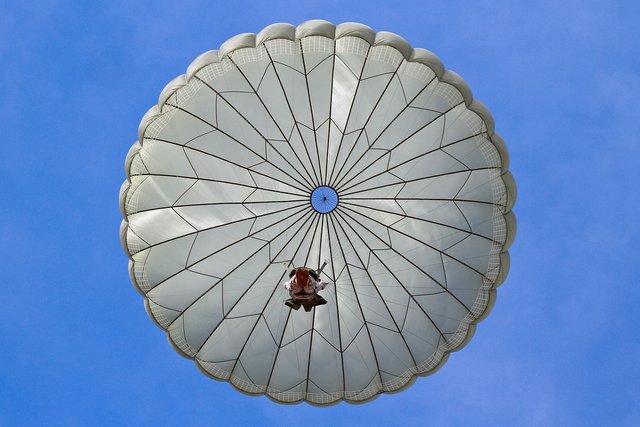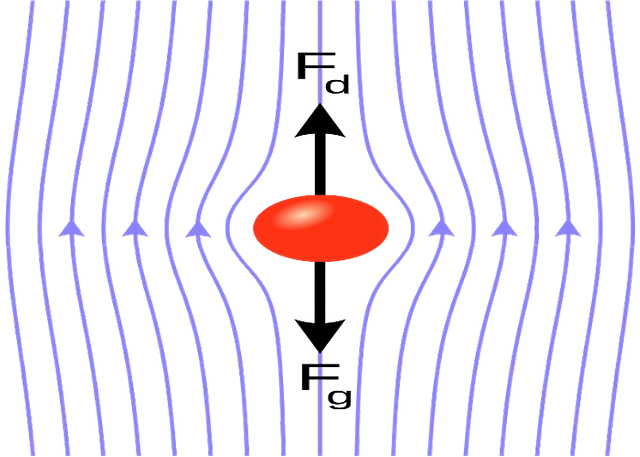Understanding The Science of Parachutes (Part 1)

[Source: Pixabay commons. CC0 licensed]
Perhaps owing to you not being a skydiver nor a soldier, you have never used a parachute in your life before. However, I am sure you may have witnessed someone used one if not in real life, then in action movies. Peradventure you have no idea of what I am talking about and haven't watched such action movies before, then the below YouTube short video clip (1.14minutes) of plane jump scene involving Dwayne Johnson and Carla Gugino in "San Andreas" Action Movie will help communicate the point. Please take a moment and watch the clip:
I hope you noticed how Dwayne Johnson and Carla Gugino were able to jump to safety with the help of a parachute when the jet engine malfunctioned and broke down [ref]. Have you ever wondered how a parachute works to help bring its users to safety? What are the different components of a parachute that work in concert to reduce the impact of gravity on its users? In this article, we are going to be taking a closer look at this and related topics.
What's a parachute?
Of course, we cannot go on talking about some concepts that would aid our understanding of the science of parachutes if we don't know what parachutes are. On that basis, let us first get to know what a parachute is.
A parachute is defined as a light nylon-based device that is worn on a body or machine primarily to slow down its motion through air (atmosphere) by creating drag which acts in opposition to the movement of the body or machine. Parachutes generally act to slow down the motion of objects through the air in order to limit damages or to ensure that no damage is sustained at all. And they come in several types including drogue parachutes which are specifically used to aid the horizontal slow down of a vehicle (which could be a fixed wing aircraft, or a space shuttle after touchdown or a drag racer) in motion. In the past, parachutes are made from silk but that's not anymore. Today, most parachutes are made from more durable woven nylon fabric.
Exploring the physics of parachutes: Free fall motion, air resistance and terminal velocity
Understanding the concepts of free fall motion, air resistance and terminal velocity is a must to be able to appreciate how a simple parachute works. It is important to point out at this point that all parachutes, irrespective of their types and designs, work on the same principle which is literally based on the concepts of particularly air resistance and terminal velocity. With that being said, we are going to demonstrate how each of these phenomena influenced the design and working mechanisms of parachutes.

[Source: Pxhere commons. CC0 licensed]
A ball thrown up in the air is sure to fall back to earth sooner or later because earth pulls everything towards itself with a force known as gravity. From our high school physics text book, we know that this force of gravity is roughly the same globally (though it varies in some places but not significantly). This means that all objects falling under the condition of free fall would do so with an acceleration of 9.8m/s/s/ (~10m/s/s) and get to the ground at the same time irrespective of their masses. This acceleration value is true for all freely falling objects and its so important that it is termed acceleration of gravity and symbolizes with a g.
Demonstrating bodies under free fall and air resistance
We learnt from the foregoing that...:
free fall is a special type of motion in which the only force acting upon an object is gravity. Objects that are said to be undergoing free fall, are not encountering a significant force of air resistance; they are falling under the sole influence of gravity. Under such conditions, all objects will fall with the same rate of acceleration, regardless of their mass. | Source
Basically, this means that, in theoretical terms, if we remove all gases from the atmosphere so that we have a vacuum, and release a stone and a sheet of paper from a skyscraper. Both should get to the ground at exactly the same time because the same force of gravity acted on them.
However, in practical terms, stone gets to ground first not because of it's heavier weight but because the paper presented a more broader surface area which was acted upon by an opposing force known as air resistance. This upward force, along with the negligible weight of the paper, was responsible for the paper falling at much slower rate than the stone, and ultimately its late arrival.
Ordinarily, it is a bit tricky to feel the force of air resistance. But that doesn't mean it does not exist. Atmosphere is full of gas molecules which has to be pushed out of the way if you want to move through it. This is only noticed when you are moving very fast. For example, when next you travel in a car just stretch one of your arms through the windscreen into the air while doing 200km/hr. You will certainly feel the force of air resistance acting on your arm in opposite direction to the movement of the vehicle.
Air resistance is very much like water resistance except that air molecules are not visible. When you jump off a diving board with your body spread out horizontally in a kinda belly flop posture and crash into a swimming pool, there will be much resistance by water molecules which will either rapidly slow down your movement or bring you to a halt. This is because your horizontal body posture presented a much larger cross-sectional (surface) area which is acted upon by water molecules against your direction of movement through the water. This resistance by water molecules increases with the speed with which you crashed into the water, and wouldn't have been as much had you crashed into the pool with legs or head because of significantly reduced cross-sectional (surface) area. In this case, you move through the water with a much faster speed.

[Sowing two opposing forces, Fd and Fg, acting on an object as it falls through the air. Source: Wikimedia commons. Author: Kraaiennest. CC BY-SA 3.0 licensed]
Similarly, when you jump out of a plane, you fall quickly through the air molecules because your body is compact with significantly reduced cross-sectional (surface) area. Hence, air resistance opposing your acceleration is not much. The situation changes when you open a parachute behind you as you fall. The parachute immediately creates a significantly large cross-sectional (surface) area, increasing the force of air resistance acting upwardly against against gravity. This makes you to drift to the ground more slowly and safely (very much like a sheet of paper released from a skyscraper).
From what we have done so far, we have been able to demonstrate that parachutes work by increasing air resistance which creates drag against a rapidly accelerating object, and considerably lowers its speed. We will stop here in order to keep this article within readable threshold. In Part 2, we will be looking at the concept of terminal velocity as it relates to parachutes, and finally the functions of different components of a typical parachute. Thanks for reading.
References for further reading
- How strong is the force of gravity on earth
- Free fall
- Free fall and air resistance
- Parachutes
- What is the science behind parachutes?
- Skydiving science
Yours truly,
@eurogee
Do You Blog About Science, Technology, Engineering, and Mathematics? If Yes, Patiently Read The Below Info


Join Euronation Community on Telegram and whatsapp through the below links to socialize with larger steemit community:

No Witnesses = No Steem Blockchain; If You Truly Love Here, Vote For Witnesses NOW!
Click This Link To Vote Now


Falling from a parachute is really fun,thank you for the info keep steeming i will follow the link immediately
I have always wanted to skydive and use a parachute but the day hasn't come so far 😂.
Thank you for teaching us the technology behind parachute.
Post curated by @syedumair
Thank you for using eSteem.
Thanks very much.
upvote for me please? https://steemit.com/news/@bible.com/6h36cq
Wow. So this summarizes the concept of free fall. I'm glad to have learnt something new today.
What an interesting way to explain physics. Nice work man @eurogee
Thanks you very much
Hi @eurogee!
Your post was upvoted by utopian.io in cooperation with steemstem - supporting knowledge, innovation and technological advancement on the Steem Blockchain.
Contribute to Open Source with utopian.io
Learn how to contribute on our website and join the new open source economy.
Want to chat? Join the Utopian Community on Discord https://discord.gg/h52nFrV
I really enjoyed reading this. A very simplified explanation of the physics of free falling with a parachute. Air resistance effect in part one. Waiting for part two!
Thanks for reading. It means a lot to me
Oh... Thank you too, my time was not wasted!
Thanks for this wonderful post , we now know that the air resistance against someone falling from plane using a parachute is not much.
I have always been fascinated by the working system of a parachute right from my childhood. but one question always remains in my heart..
what if there is an all of a sudden puncture on the parachute??
It would have a negligible effect on the descending speed because even parachute itself has a central opening apex or top vent which allows slow escape of air. Without this, the umbrella would be torn to pieces by air resistance.
Glad to see you hear
@eurogee of @euronation and @steemstem communities